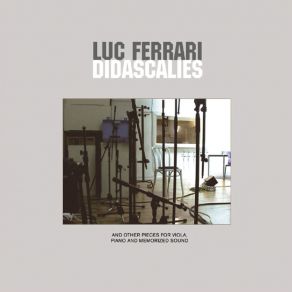Didascalies
Download links and information about Didascalies by Luc Ferrari. This album was released in 2007 and it belongs to Alternative genres. It contains 3 tracks with total duration of 59:40 minutes.

|
|
|---|---|
| Artist: | Luc Ferrari |
| Release date: | 2007 |
| Genre: | Alternative |
| Tracks: | 3 |
| Duration: | 59:40 |
| Buy it NOW at: | |
| Buy on iTunes $10.99 | |
| Buy on Amazon $2.67 | |
Tracks
[Edit]| No. | Title | Length |
|---|---|---|
| 1. | Rencontres Fortuites | 23:14 |
| 2. | Tautologos III | 21:19 |
| 3. | Didascalies | 15:07 |
Details
[Edit]This album is the last part of a triptych that had been planned while Luc Ferrari was still alive. In fact, the first volume, Les Anecdotiques (a hörspiel) was released before his death; then came Son Mémorisé (a collection of electro-acoustic works) and finally Didascalies. The latter is devoted to Ferrari's instrumental music and culls two recent works ("Rencontres Fortuites" and "Didascalies") and an older piece recently re-executed ("Tautologos III"). The first two are written for piano, viola, and "memorized sounds" (i.e., tape) and were composed specifically for Jean-Philippe Collard-Neven and Vincent Royer, while the last piece is an open-ended work with unspecified instrumentation, here performed by the same two musicians. The whole album was recorded only weeks before Luc Ferrari's death in August of 2005. That sad note aside, Didascalies is a very strong album, possibly the best recording of any of the composer's instrumental works. "Rencontres Fortuites" (23 minutes) is actually a suite of eight sequences defined by unrelated tape parts — and some very odd ones at that: a woman sighing under Ferrari's meticulous directions, models recorded in a dressing room, and other improbable settings. Collard-Neven and Royer weave an unstable dialogue through these memorized sounds, creating awkward moods. The piece is certainly interesting and puzzling, but it does not engage the listener as strongly as "Didascalies" (21 minutes) does. That piece is pure Ferrari genius: each musician selects a motive and sticks to it, transforming it in reaction to the other musician's motive and to "stage directions" (the translation for the French word "didascalies"), while a tape part (again typically Ferrari-esque: both evocative and anecdotal) is superimposed on the result. Collard-Neven and Royer quickly give the piece a yearning, melodramatic atmosphere, filled with tension and just a bit of that over-exaggeration that was Ferrari's form of humor. "Tautologos III" uses a similar device, i.e. repetitive motives attracting each other over time, although what drives this particular piece is accretion. If the compositional devices (and tape parts) are occasionally mechanical in nature, the execution is never cold, breathing a lot of humanity into these unusual constructs. [A bonus DVD edition was issued in 2007 as well.] ~ François Couture, Rovi